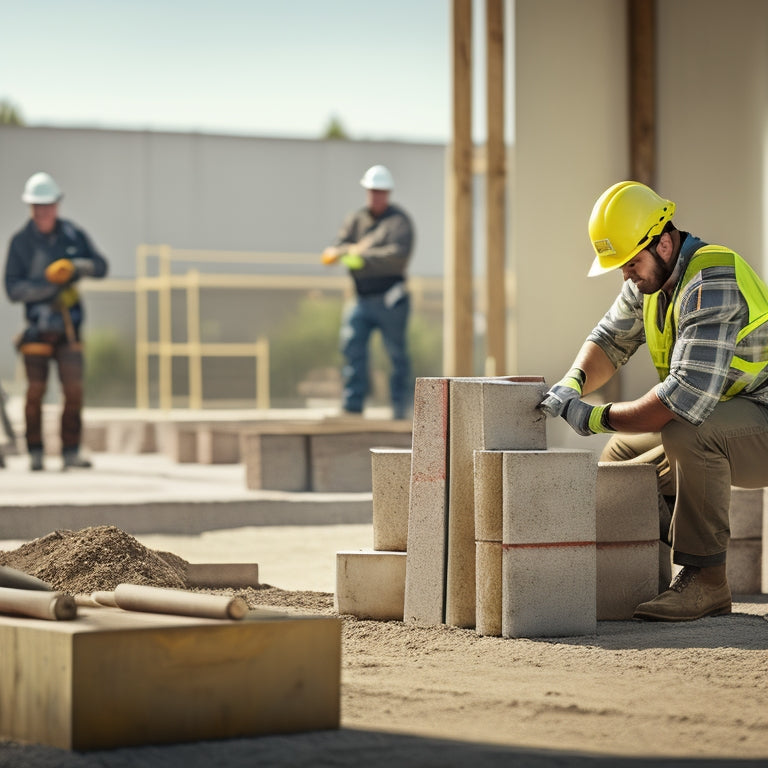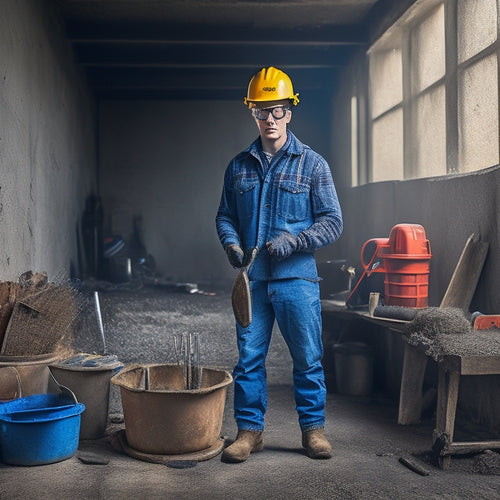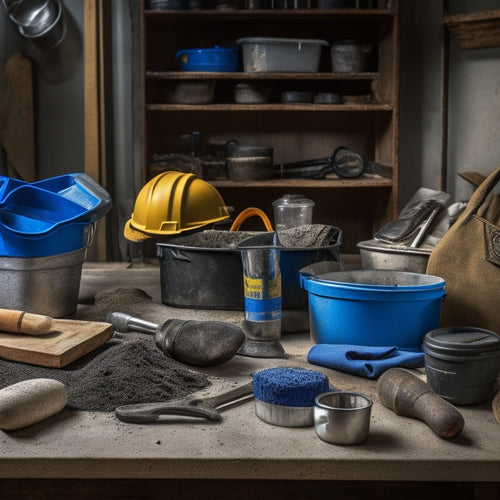
Top Tools for Accurate Concrete Block Laying
Share
You'll need a combination of specialized tools to guarantee accurate concrete block laying, starting with essential leveling tools like spirit levels and laser levels that ensure precise vertical and horizontal alignment. Measuring and marking tools, such as tape measures and chalk lines, are also critical for guaranteeing seamless fits and reducing errors. Cutting and shaping equipment, including diamond saws and block chisels, enable accurate cuts and angular shaping. By using these tools correctly, you'll be able to maintain structural integrity and achieve a professional finish - and understanding how to optimize their use will make all the difference in your project's success.
Key Takeaways
• Accurate leveling tools, such as spirit levels, torpedo levels, and laser levels, ensure precise block alignment and prevent costly mistakes.
• Essential measuring and marking tools, including tape measures and chalk lines, guarantee accurate cuts and layouts for a professional finish.
• Cutting and shaping equipment, like diamond saws and block chisels, facilitate precise cuts and angles, maintaining structural integrity.
• Proper mixing and pouring techniques, along with specialized tools, are crucial for a strong and durable final structure.
• Finishing and smoothing tools, including trowels, floats, and edging tools, achieve a smooth, even, and aesthetically pleasing surface.
Leveling Tools for Block Laying
You'll need a spirit level and a torpedo level to confirm your block courses are perfectly horizontal and vertical during the laying process. These essential leveling tools confirm your concrete blocks are accurately positioned, preventing costly errors and structural weaknesses.
A spirit level is a simple yet effective tool that indicates when a surface is level or plumb. It's ideal for checking individual blocks or small sections of the wall.
In contrast, a torpedo level is a compact, highly accurate tool designed for checking levels in tight spaces. Its slender design allows it to fit into narrow gaps, making it perfect for checking courses as you lay them.
For larger projects or more complex layouts, consider investing in laser levels. These advanced tools project a level line or plane, providing a precise reference point for your block laying.
Measuring and Marking Essentials
With your block courses accurately leveled, you can now focus on measuring and marking the concrete blocks to secure precise cuts and layouts. This step is essential in guaranteeing that your blocks fit together seamlessly and your structure is square.
To begin, you'll need a reliable tape measure to take precise measurements of each block. Look for a tape measure with clear markings and a sturdy hook that can withstand the rigors of construction.
Next, use a chalk line to mark the blocks for cutting. This will give you a clear guide for your saw or other cutting tools. When snapping the chalk line, make sure to hold it taut and level to avoid any deviations.
Take your time and double-check your measurements to secure accuracy. By following these steps, you'll be able to make precise cuts and layouts, resulting in a professional-looking finish.
With your blocks properly measured and marked, you can move on to the next stage of the block laying process with confidence.
Cutting and Shaping Equipment
Using a masonry saw or a circular saw, accurately cut the marked concrete blocks to fit together seamlessly and maintain the structure's integrity. This is a critical step in concrete block laying, as precise cuts guarantee a stable and durable structure.
To achieve accurate cuts, you'll need the right cutting and shaping equipment. Here are some essential tools to take into account:
-
Diamond saws: Ideal for cutting through concrete blocks quickly and efficiently, diamond saws are a must-have for any concrete block laying project.
-
Block chisels: Perfect for shaping and refining concrete blocks, block chisels come in various sizes and are essential for achieving precise cuts and angles.
-
Concrete cutting trowels: These handheld tools are used to remove excess concrete and smooth out cut edges, guaranteeing a professional finish.
Mixing and Pouring Tools
Accurate mixing and pouring of the concrete mixture are essential steps in concrete block laying, as they directly impact the strength and durability of the final structure.
You'll need to master various mixing techniques to guarantee a consistent and homogeneous mixture. This includes understanding the ideal water-to-cement ratio, using the right mixing equipment, and adopting efficient mixing sequences. A mixing drum or a mortar mixer are ideal tools for this task.
Once you've mixed the concrete, it's time to pour it into the molds or forms. You'll need to employ proper pouring methods to minimize air pockets and guarantee a smooth, even finish. This may involve using a pouring bucket or a chute to direct the flow of concrete.
A vibrating table or a tamping tool can also help to remove air bubbles and compact the mixture. By using the right mixing and pouring tools, you'll be able to achieve a strong and durable concrete structure that meets your project's requirements.
Finishing and Smoothing Tools
You'll now move on to the finishing stage, where you'll employ specialized tools to refine the concrete block's surface and achieve the desired texture and appearance. This stage requires attention to detail and the right tools to guarantee a smooth, even finish.
To achieve a professional-looking finish, you'll need a range of finishing and smoothing tools. These include:
-
Trowels: Choose from various trowel types, such as V-notched, square-notched, or pool trowels, depending on the texture and pattern you want to achieve. Each type is designed for specific float techniques and surface finishes.
-
Floats: Use a bull float or a fresno to level and smooth the surface, removing any excess material and creating a uniform base for further finishing.
-
Edging tools: Use specialized edging tools, such as edging trowels or edgers, to create clean, sharp edges and define the block's shape.
Frequently Asked Questions
How Do I Prevent Concrete Blocks From Getting Damaged During Transportation?
When transporting concrete blocks, you'll want to guarantee they arrive at the site undamaged.
To do this, you should carefully select transportation methods that minimize block handling. You can use padded or covered trailers to reduce exposure to the elements and prevent chipping.
Additionally, consider using block straps or nets to secure the blocks during transport, reducing the risk of movement and subsequent damage.
What Safety Gear Is Essential for Concrete Block Laying Workers?
When you're working on a concrete block laying project, you'll need to prioritize your safety above all else.
You must wear essential safety gear to prevent injuries. This includes hard hats, safety glasses, earplugs, and dust masks to protect yourself from falling objects, flying debris, and airborne particles.
Additionally, wear steel-toed boots, gloves, and high-visibility vests to guarantee your overall protection.
Don't forget to wear knee pads and waterproof trousers to prevent skin abrasions and wet conditions.
Can I Use a Laser Level for Indoor Concrete Block Laying Projects?
You're wondering if a laser level is suitable for indoor concrete block laying projects. The answer is yes! A laser level offers several benefits, including increased accuracy and efficiency.
When working indoors, it's crucial to evaluate the project's unique challenges, such as limited space and potential interference from other tools.
To get the most out of your laser level, follow indoor project tips like setting up a stable tripod and using a receiver to detect the laser beam.
How Often Should I Clean My Concrete Block Laying Tools?
You'll be digging yourself into a hole if you don't maintain your tools - literally!
When it comes to tool maintenance, cleaning frequency is essential. You should clean your concrete block laying tools after every use, and perform a deep clean weekly.
This guarantees accuracy and prevents damage. Daily cleaning removes dirt and debris, while weekly cleaning tackles rust and corrosion.
Stay on top of it, and your tools will stay in top shape.
Are There Any Specific Regulations for Concrete Block Laying in My Area?
You need to familiarize yourself with local building codes and zoning regulations governing concrete block laying in your area.
Research online or visit your local government's website to access relevant information.
Additionally, consult with local authorities or a licensed contractor to guarantee compliance with specific regulations.
They can provide valuable insights and help you navigate the complex rules and standards that apply to your project.
Conclusion
You've got the top tools for accurate concrete block laying at your disposal, but the real challenge is yet to come.
As you commence your project, remember that precision is key. One miscalculation, one misplaced block, and the entire structure can come crumbling down.
The stakes are high, but with these tools and your expertise, you're ready to take on the challenge.
Will you rise to the occasion, or will your project fall short? The outcome is in your hands.
Related Posts
-

What Tools Do I Need for Concrete Wall Repair
As you prepare for a concrete wall repair job, you'll need a variety of tools to guarantee a successful outcome. Star...
-

5 Tools Needed for Quick Fix Concrete Mixing
You'll need five essential tools to tackle a quick fix concrete mixing project efficiently. First, you'll require a s...
-

Essential Power Tools for DIY Concrete Sculpting
As you begin DIY concrete sculpting, you'll need a strategic selection of power tools to achieve professional-grade r...


